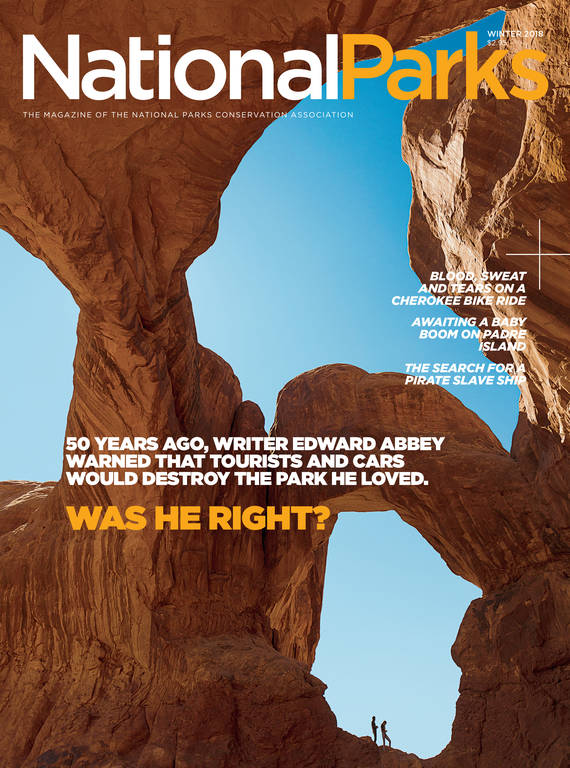Winter 2018
Following In Their Footsteps
Could they ever understand what their ancestors endured? They biked hundreds of miles along the Trail of Tears to find out.
Hunter Scott began his 17th birthday in a Pizza Hut parking lot. It was a cool June morning in the Missouri Ozarks, but the rising sun was already warming the air. Squeezed into a circle of 20 cyclists standing with their bikes, Scott laughed nervously in anticipation.
Slim and pale-skinned, with a mess of dark curls, Scott looks more like an artist than an athlete. At home in eastern Oklahoma, he lives by the guidance of Master Yoda, geeks out over anime and sometimes plays the mandolin and fiddle. He’s shy with strangers and feels awkward speaking in front of groups. But since it was his birthday, he was tasked with doing something well outside his comfort zone: leading the morning war cry.
The cyclists stood silently, waiting.
“Take it serious,” someone called out.
“All right, I’m tryin’,” Scott said. He fidgeted with his helmet and took a few deep breaths. Then all at once, he clenched the bike handlebars, bent his knees, clamped his eyes shut, tilted his head back and let out a long, hair-raising cry. He did it again, five times in all, and each time the group answered with a shout. When it was over, everybody applauded, and Scott — gazing downward — fist-bumped the rider next to him. Moments later, the cyclists clipped into their pedals and coasted out of the parking lot single file, heading south toward Arkansas.
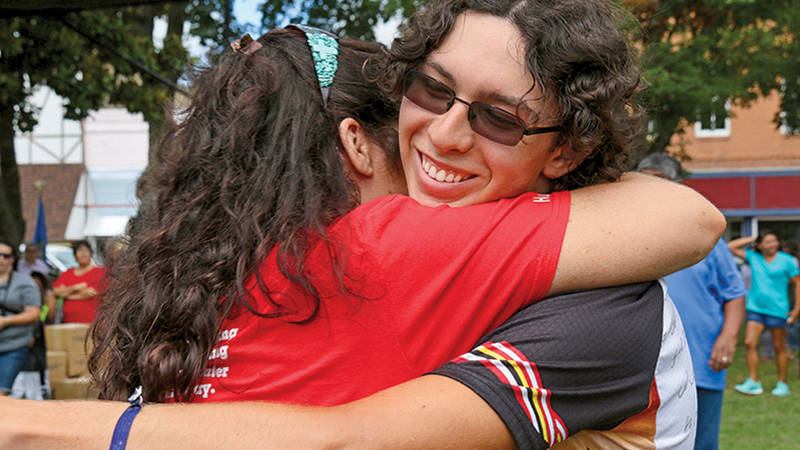
Hunter Scott, 17, grew up hearing his elders’ stories, but before the ride, he sometimes had a hard time relating to them.
© STACIE GUTHRIE/CHEROKEE PHOENIXFor several years, Scott had heard from fellow Cherokee about an intense three-week, 950-mile bike ride along the Trail of Tears — the path their ancestors followed when they were forced west 180 years ago.
“The ride changes you,” they’d told him. Scott had largely dismissed the idea that a bike ride could be life-changing, but he always appreciated a physical challenge. Although he hadn’t ridden a bike since he was a kid, he ran cross country and track at his high school and figured a long bike ride couldn’t be that difficult. So in 2016, when he was a high school junior, he applied to join the ride, called Remember the Removal.
The ride commemorates a horrific chapter of American history when the federal government drove Native Americans from their homeland in the Southeast to Indian Territory, in what is today Oklahoma. Over several years, the Cherokee protested both the Indian Removal Act of 1830, signed by President Andrew Jackson, and the Treaty of New Echota, which set the conditions for their removal. The Cherokee refused to leave their tribal land, so in May of 1838, soldiers began forcing families from their homes. After an initial army-led relocation plagued with disease and death, the tribe negotiated to oversee their own removal. In 1838 and ’39, around 12,000 Cherokee people traveled by foot, horse and wagon for 800 miles, in 13 detachments. Thousands died from disease, starvation or cold. (Estimates of this figure vary, but according to Jack Baker, the president of the National Trail of Tears Association, nearly 2,000 Cherokee died during the roundup, at camps and along the trail, and about 2,000 more died within a year of moving west.)
The Cherokee took several routes, collectively called the Trail of Tears; today those paths are paved roads, fields, parks and yards. The Trail of Tears National Historic Trail, which was designated in 1987, stretches 5,043 miles across nine states and recognizes dozens of sites. Though the trail primarily marks the Cherokees’ journey, the government also removed four other tribes — the Choctaw, Chickasaw, Seminole and Muscogee (also known as Creek) — from their homelands in the 1830s.
The Cherokee Nation organized the first Remember the Removal ride in 1984 for tribal youth. The hope was that it would boost their confidence and help them develop leadership skills; Cherokee also wanted to bring attention to the removal trails so the federal government would officially mark them. The ride was held just once, then resurrected as an annual event 25 years later, in 2009. Today, Remember the Removal retraces the Northern Route as closely as possible. It starts in Georgia, passes through Tennessee, Kentucky, Illinois, Missouri and Arkansas and ends in Tahlequah, Oklahoma, the capital of two Cherokee tribes.
Growing up, Scott went to stomp dances with his mother, where he listened to the elders’ stories. His grandfather sometimes spoke about the family’s Cherokee history, but Scott had a hard time relating to events that happened long ago. “It was just a crazy story my grandpa was telling,” he said.
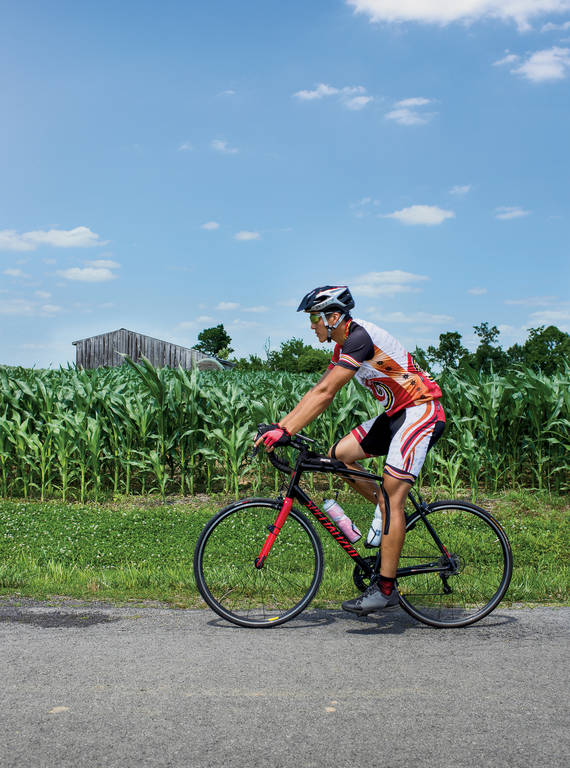
Ellic Miller bikes along the Trail of Tears in Kentucky.
© KRISTINA KRUGHe felt similarly distant from the Trail of Tears. “They say it was hard, and I kind of cared, but you don’t know what it was like,” he said. “I felt like it was long over and done with.”
After he submitted his application for the ride, Scott sat before a panel of Cherokee Nation interviewers who asked him why he wanted to participate and how he’d use the experience to improve the Cherokee community. He calmly talked about working after school as a tutor and preparing backpacks of food for needy children. But he struggled with a few questions, and when he walked out, he told his mom he’d bombed it. So his acceptance came as a surprise. When the letter arrived, his mother hid it until Christmas and then broke the good news in front of the entire family.
Training began in January at a local gym. After the group’s first ride together, a 10-mile spin workout, Scott’s legs were like jelly. Though he was the youngest rider, he wasn’t the only novice. Among those selected, most were new to road bikes, and some were altogether new to fitness. The riders worried about making friends, keeping up and reaching downhill speeds of 40 mph. For many, it would be their longest time away from home.
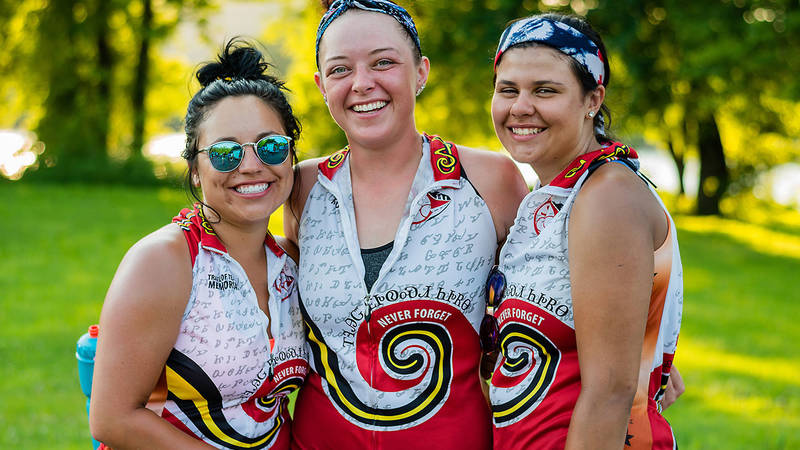
KenLea Henson, Shelby Deal and Macie Sullateskee (from left to right) take a break from the saddle. Deal bounced back from a three-person bike crash during training last spring that had left her shaken, with a concussion and scars on her shoulder, elbow and knee. On the day she led the ride, Deal was nervous but resolute. “I’m not a quitter,” she said.
© KRISTINA KRUGAs winter turned to spring, the riders learned to clip into road bike pedals and draft off each other. They discovered the wonders of inner thigh cream to prevent chafing and tried to accept that pop and fries weren’t the best foods for refueling. On the weekends, the cyclists — some of whom had only a rudimentary understanding of the Trail of Tears — took classes in Cherokee language and history. They rode though the hills of Oklahoma and at one point survived a crash that sent three riders to the emergency room. Near the end of training, the ride organizers distributed genealogy reports that showed that many of the cyclists — strangers in January — were kinfolk.
In North Carolina, a team of older riders from the Eastern Band of Cherokee Indians was training in parallel. At the end of May, the two groups met for the first time in Cherokee, North Carolina. In all, there were 20 riders, ages 16 to 50, including a former soldier with an easy smile, a college student who serves food at a hotel and casino, a jazz guitarist who wants to practice medicine at a Native American hospital, an aspiring lawyer, and a mother with tribal tattoos.
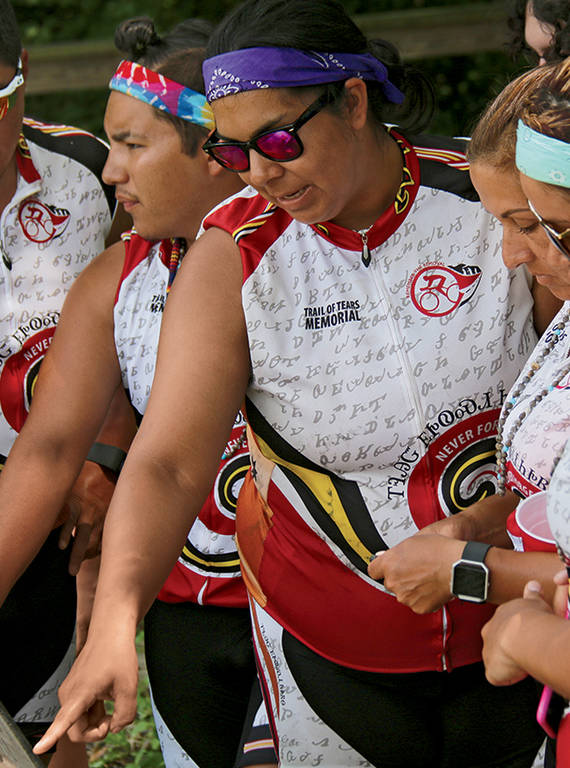
Sheyahshe Littledave (pointing in center), who has two small children, said, “If you’d told me a year ago I’d be riding three weeks to Oklahoma, I would have laughed — I thought it would be impossible for me. But I can look my kids in the eye and tell them, ‘It’s possible. Dream your dreams.’”
© STACIE GUTHRIE/CHEROKEE PHOENIXOne of the Eastern Band riders, Sheyahshe Littledave, 32, was hoping the ride would help pull her out of a funk. “I struggled with a lot, including my ability, my weight, the voice in your head that said you’re too out of shape, you can’t do this,” said Littledave, a newly single mom with two children under the age of 4. All through training, she said, self-doubt plagued her. “I questioned myself every time I got on the bike. What carried me is knowing our ancestors didn’t have a choice. I’m choosing to do this.”
Will Chavez, who participated in the inaugural ride, returned this year as a mentor rider. A stocky, soft-spoken man who loves history and quotes Seinfeld, Chavez said the first ride was quite different: Riders camped the whole way and called home on pay phones; much of the trail was unmarked. “It was uncharted territory,” he said. “We didn’t know if we were going to make it home.” Chavez — now 50 and an assistant editor at the Cherokee Phoenix newspaper in Oklahoma — knew this ride would challenge him in new ways. Throughout training, he did his best to manage old, nagging injuries, shared stories from ’84, and encouraged the younger riders. When they were exhausted or their spirits were low, he spoke about their ancestors, reminding them of the importance of what they were doing.

Will Chavez, an assistant editor at the Cherokee Phoenix newspaper in Oklahoma, served as a mentor rider. In 1984, when he was 17, he participated in the inaugural event, riding with a photograph of his grandfather — who spoke only Cherokee and had died the year before — attached to his bike bag for inspiration.
© KRISTINA KRUGThe riders spent a couple of days team-building and training together. They visited Kituwah Mound in the Great Smoky Mountains, considered the “mother town” of the Cherokee Indians. On the morning of June 4 in New Echota, the original Cherokee Nation capital (today Calhoun, Georgia), the cyclists gathered and held hands. After prayer and a war cry, they began their journey.
The group first headed north out of Georgia and into Tennessee, riding between two vans towing bike trailers. The first day, they pedaled 55 miles through intermittent rain, so heavy at times that it was hard to see. At one point, Scott swerved slightly onto the shoulder. When he tried to correct course, his wheel hit a thin ledge between the shoulder and the road, and he flipped onto the pavement. He scraped his thighs and shoulder and tore the skin off his elbow. It took him a few seconds to realize he was bleeding.
That night, he was reluctant to tell his mother what had happened. After some prodding, he texted, “Don’t freak out but I crashed today.” His mom reminded him to use antibiotic ointment and take Tylenol, and he texted back photos of his road rash.
The next day, though, he was up and about with the rest of the crew, groggily pulling his bike from the trailer. At times, during the quiet of the morning, the only sound was the click of bike shoes as everyone crisscrossed the pavement, pumping tires, filling water bottles and spraying sunscreen. Then, a bit later than planned, the riders saddled up and hit the road.
Gradually, the days started to take on a familiar rhythm: Once the cyclists were rolling, they stopped every hour or so to fix a flat, treat a bloody nose or wait for traffic. The van drivers played den mothers, walking around with water, sandwich bags of sliced fruit and energy chews. Each day, they covered 20 to 70 miles; when traffic was gnarly, they’d ride for stretches in the van. This accounted for slightly lower mileage than the itinerary suggested (one woman clocked the entire trip at closer to 750). While riding, the cyclists practiced speaking Cherokee to each other: “I-da-le-wi-s-di” for “We’re stopping,” and “u-di-tle-ga” for “It’s hot.” Occasionally they’d hear a van driver’s voice across the walkie-talkie, “Road-keeeel!” And they’d swerve to avoid an armadillo.

Skylar Vann (left), Trey Pritchett (middle) and Brea Anderson (right) linger at Mantle Rock, a spot along the Trail of Tears where hundreds of their ancestors were stranded during an unusually harsh winter.
© KRISTINA KRUGAlong the way, the group visited historical locations where Cherokee stayed during the removal, including several sites with graves of those who had died en route. At the Cherokee Removal Memorial Park at Historic Blythe Ferry in eastern Tennessee, some riders were able to find names of their ancestors on the memorial walls. At Rattlesnake Springs, near Charleston, Tennessee, they learned about an encampment where Cherokee were held after they were forced off their land; some died on what is today a field of green grass.
After a hilly, humid, 70-mile day in Kentucky, the riders parked their bikes and walked a half-mile to Mantle Rock, a large sandstone arch formation in the western part of the state. An unusually harsh winter during the removal froze the Ohio and Mississippi rivers, preventing ferry transportation to Illinois for several weeks. The arch provided some shelter while the group was stranded, but some people died there, and in all, that detachment of 1,700 lost around 300 people before their journey was over.
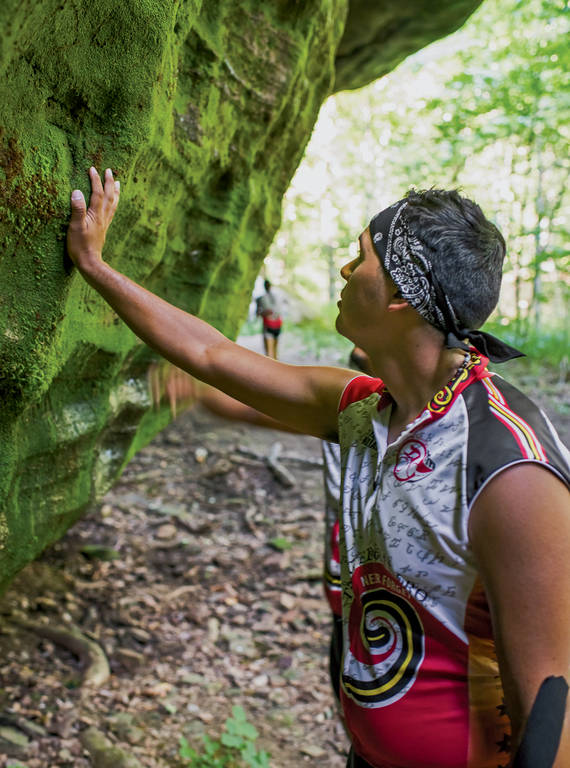
Skylar Vann, 23, at Mantle Rock, an emotional stop on the trip. “I have a 2-year-old niece,” he said. “I think of what it would be like for her to walk the Trail of Tears.” A student at Northeastern State University in Tahlequah, Vann is majoring in Cherokee cultural studies and minoring in Cherokee language. He grew up hearing his family speak Cherokee at home and would like to teach his nieces and nephews to speak the language. “I’ve always seen myself as some sort of teacher,” he said, adding, “it’ll be cool to tell my children and grandchildren what I learned on the ride.”
© KRISTINA KRUGAt the site, Skylar Vann, 23, a student at Northeastern State University in Tahlequah, led a small group in singing a hymn, “One Drop of Blood,” that their ancestors sang to get through difficult times. Scott said he thought about all the Cherokee who had died there. In a way, it felt like they were holding a funeral for their forebears, said Renissa McLaughlin, 49, the director of a Cherokee language and culture program in North Carolina.
“I can’t imagine turning to my kid and saying, ‘We’re not going home. I don’t know where we’re going. I don’t have any food,’” said McLaughlin, who has three children, ages 28, 24 and 13. “Then I was angry at myself for griping about walking in mud in my expensive shoes with my expensive bike.”
Everyone was pretty quiet, Littledave said. “I got overwhelmed with guilt and shame because I thought, ‘What have I done prior to this to remember the removal?’ Honestly, nothing,” she said. “To be there, where our ancestors sat, knowing what they felt, was the worst feeling.”
Halfway through the second week, it was Scott’s turn to lead. He set the pace, used hand signals and carried a walkie-talkie to communicate with the van drivers and the Cherokee Nation marshals who were escorting them. His mom later texted and asked him how it went. “Fun,” he wrote, “but probably the most stressful thing I’ve ever done.”
The eight days across Missouri were long and hot. Chavez described one hill before Springfield as “a wall” and complained about long stretches of broken and cracked pavement along Route 66. The ride was physically exhausting, and cyclists fought homesickness.
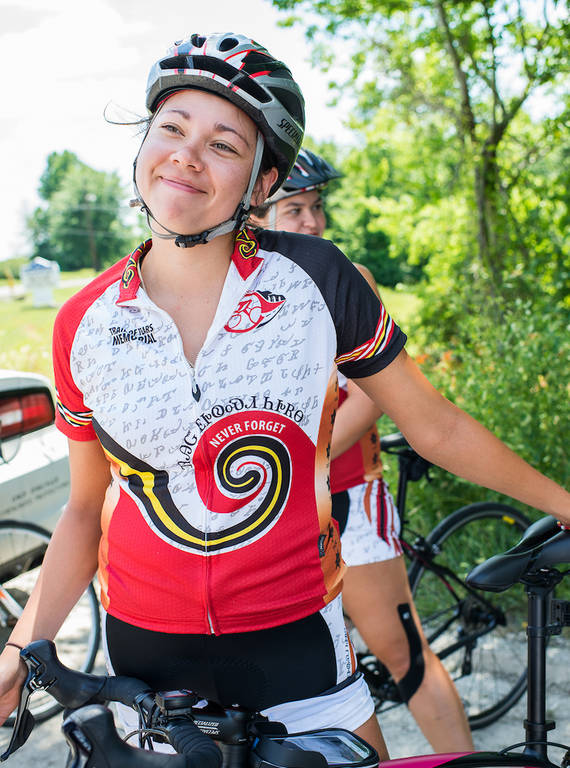
A jazz guitarist, Brea Anderson graduated from the University of Tulsa last spring, majoring in music, and started medical school there the week after she finished the ride. “I would love to work for an Indian hospital, maybe in Tahlequah,” she said. “I’d like to help Native Americans who need assistance and give back to my heritage and culture. The reason I’m here is because my ancestors survived the removal.”
© KRISTINA KRUGOn days that he wondered if he would finish, Vann thought about his family. He called home most nights. “My mom kept asking me, ‘What would you do if that was us on the trail,’” he said. “My dad said, ‘That was us on the trail, that was our ancestors.’”
Chavez said he sometimes felt the presence of those who came before. At the spot of a former holding camp, he saw a wall of rain moving toward the group. “All of a sudden, it stopped,” he said. “And it disappeared. I think our ancestors intervened.” He often thought about his friends from the trip in ’84; many of them have remained close in the decades since the ride.
“It’s incredible that 30 years later, they think about this event, and it still helps get them through difficult times,” said Melissa Lewis, a health researcher at the University of Missouri, who is collaborating with the organizers to study the ride’s impact. She interviewed riders who participated in 1984 and 2015 as part of her research and found that they felt a stronger connection to the tribe and were physically and emotionally healthier than their peers.
When they arrived in Springfield, the riders had two weeks behind them and one to go. The night before their second off-day, they were giddy thinking about sleeping in and shedding their bike shorts. Midday the next afternoon, they gathered in the hotel parking lot to oil their bikes and clean the vans, by now littered with fetid socks, empty drink bottles, banana peels and energy bar wrappers. Chavez tracked down a masseuse for his aching back, and a handful of riders went to see a minor league baseball game, where they ate funnel cake and hot dogs.
Scott celebrated his birthday on the final day in Missouri, just days before their Tahlequah homecoming. Sarah Holcomb, 28, the group trainer and the daughter of an ’84 rider, went over the day’s schedule, including a stop next to a spring where their ancestors had camped. “They knew they were almost in Oklahoma,” she said. “They were tired of walking these hills.”
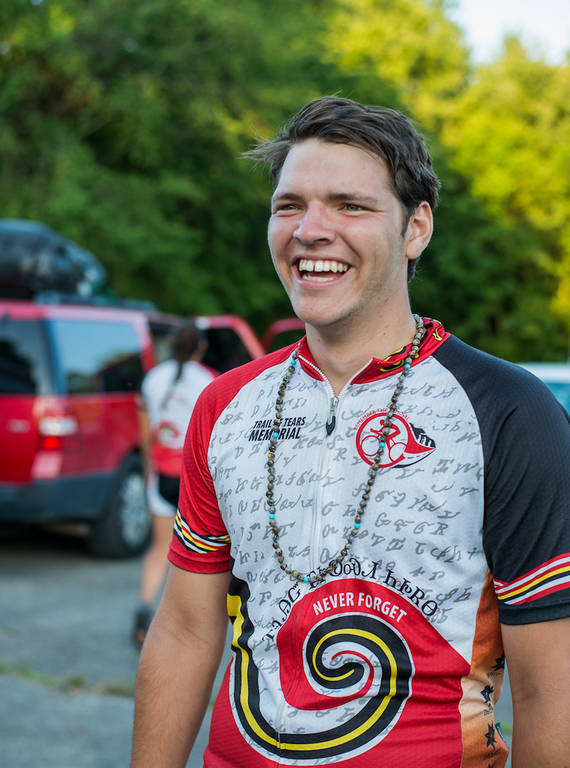
Brian Barlow, who graduated from George Washington University in 2016, finished the ride using some of the same tactics that got him through college. “It’s mind over matter,” he said. “I told myself, ‘One day at a time. One hill at a time. You’ve done this before; don’t let the fear stop you from finishing.’” Barlow, who sat on the Cherokee Nation Youth Council, is eager to further serve his community in Tahlequah. Among his current projects, he’s working with the local Walmart to label produce with Cherokee names. As he biked through the hills of Oklahoma at the end of the ride, Barlow thought about his ancestors who made Tahlequah their home. “They were going to a new place,” he said. “For me, it’s a privilege that I can come into those same hills, and this is my home.”
© KRISTINA KRUGThe route that day mostly followed curvy two-lane farm roads. On straightaways, the cyclists spread out, often absorbed in thought. Under washboard-like clouds, they passed dilapidated barns, roadside watermelon stands and fields of yellow wildflowers. They spooked a herd of cows and inspired a few horses to run alongside.
At lunchtime, the group stopped at Pea Ridge National Military Park in Arkansas and strolled on a grassy section of the Trail of Tears. After a picnic of catfish and hush puppies, they rode into Fayetteville, and the park superintendent, Kevin Eads, hosted them at his house for dinner.
“I’m extremely impressed with the riders and what they’re doing,” said Eads, who is Cherokee and has been hosting riders since 2009. “This is one small way of showing our respect.”
Approaching the Oklahoma state sign, one rider was so excited to make a video with his phone that he fell off his bike. The cyclists sat on each other’s shoulders and posed for photos, and an 18-wheeler honked as it sped by.
The group slept in a school gymnasium that evening, the night before their homecoming, and woke to a muggy and overcast morning. Chavez, the day’s leader, announced that he would like Littledave, whom he had taken under his wing, to ride into Tahlequah next to him. As the group pedaled west on Highway 51, cars pulled over to watch. People began lining the streets, cheering and waving. They passed landmarks familiar to the Oklahoma natives: the Cherokee County water tower, a small family cemetery and a tobacco outlet. They crossed the Illinois River and pulled over.

National Parks
You can read this and other stories about history, nature, culture, art, conservation, travel, science and more in National Parks magazine. Your tax-deductible membership donation of $25 or more entitles…
See more ›A little less than four miles to the west, a crowd of hundreds awaited the riders outside the Cherokee Nation courthouse. Dignitaries prepared to welcome them, and families held fluorescent signs. Scott’s clan was 20 strong, including his family, his girlfriend and the ponytailed preacher who had baptized him in a horse trough. They wore red T-shirts printed with Scott’s name on the sleeve.
But before rolling into Tahlequah and reuniting with their families, the cyclists stood together at the river bank to savor their last quiet moments together. A Cherokee spiritual leader joined them. “You are an answer to our ancient ancestors’ prayers,” he said. Holcomb asked them to share final thoughts.
“This ride meant the world to me,” said one woman.
“I was in a hole,” Littledave said. “This ride saved me.” One by one, each of them spoke, and many wept.
About the Photographer
The night before, Cherokee Nation Principal Chief Bill John Baker had asked the riders to talk about the most spiritual moment of the journey. Sitting on the gym floor, Scott had struggled to get his words out. “This is way harder than the bike ride,” he had said nervously.
But at the river, as the water babbled and starlings chattered overhead, Scott spoke effortlessly. “I consider you guys as my family,” he said. “And I love you all to death.”
About the author
-
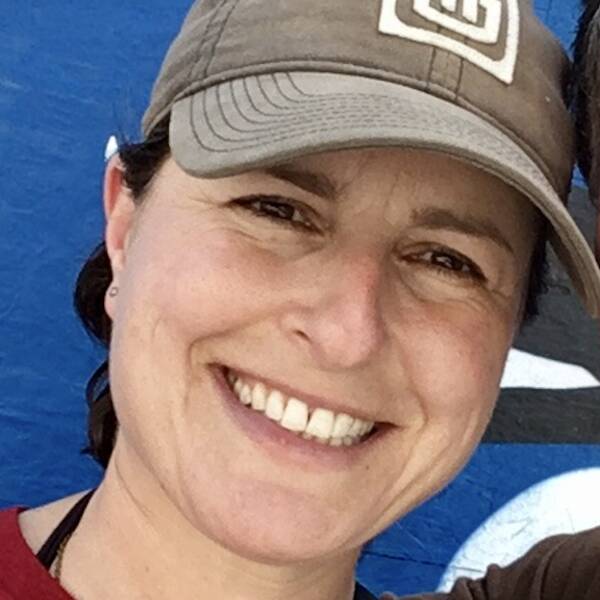 Melanie D.G. Kaplan Author
Melanie D.G. Kaplan AuthorMelanie D.G. Kaplan is a Washington, D.C.-based writer. Her book, "LAB DOG: A Beagle and His Human Investigate the Surprising World of Animal Research," will be published by Hachette in 2025.
